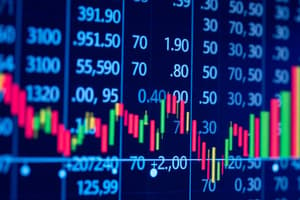Podcast
Questions and Answers
What is the primary distinction between causation and correlation as illustrated in the effect of education on wages?
What is the primary distinction between causation and correlation as illustrated in the effect of education on wages?
- Correlation implies that education directly affects a person's intelligence.
- Causation can be established through observational studies.
- Correlation suggests a relationship between education and wages, but does not imply direct causation. (correct)
- Causation indicates that education will always lead to higher wages.
In an observational study investigating the relationship between education and wages, what assumption is typically made?
In an observational study investigating the relationship between education and wages, what assumption is typically made?
- The relationship between education and wages is strictly causal.
- All factors influencing wages are allowed to vary.
- Experience and ability are controlled for in the analysis. (correct)
- Data is collected only from individuals with the same job.
Why is random assignment for education studies considered infeasible?
Why is random assignment for education studies considered infeasible?
- It is unethical to assign education levels randomly.
- Education levels cannot be measured accurately.
- It would require controlling for too many variables simultaneously.
- Education is influenced by factors like intelligence, which complicates randomness. (correct)
What type of data is best suited for establishing economic models in econometrics?
What type of data is best suited for establishing economic models in econometrics?
In econometric models, which of the following statements is true concerning the relationship between dependent and independent variables?
In econometric models, which of the following statements is true concerning the relationship between dependent and independent variables?
What type of economic data represents observations at a specific point in time without any time dimension?
What type of economic data represents observations at a specific point in time without any time dimension?
Which of the following types of data includes repeated observations over time for the same entities?
Which of the following types of data includes repeated observations over time for the same entities?
Which of the following types of data is NOT exclusively tied to a single time point?
Which of the following types of data is NOT exclusively tied to a single time point?
What is a common characteristic of time series data?
What is a common characteristic of time series data?
Which type of econometric model would be appropriate for analyzing wage data collected for various individuals at a single point in time?
Which type of econometric model would be appropriate for analyzing wage data collected for various individuals at a single point in time?
Which statement best describes pooled cross sections?
Which statement best describes pooled cross sections?
Which type of data would be the best choice to analyze GDP over the past decade?
Which type of data would be the best choice to analyze GDP over the past decade?
In the context of econometrics, when analyzing serially correlated errors, which type of data should be considered?
In the context of econometrics, when analyzing serially correlated errors, which type of data should be considered?
What is the significance of pooled cross-sectional data, as mentioned?
What is the significance of pooled cross-sectional data, as mentioned?
Which of the following statements about the house prices data is accurate?
Which of the following statements about the house prices data is accurate?
From the provided house prices data, what can be inferred about the price per room?
From the provided house prices data, what can be inferred about the price per room?
What was the average minimum wage observed in the year 1952?
What was the average minimum wage observed in the year 1952?
What characterizes panel data?
What characterizes panel data?
Which variable in the panel data example represents wages?
Which variable in the panel data example represents wages?
What is the primary difference between causation and correlation in economic studies?
What is the primary difference between causation and correlation in economic studies?
In the context of the fertilizer example, what is an implication of conducting a valid experiment?
In the context of the fertilizer example, what is an implication of conducting a valid experiment?
Which statement best describes an observational study in the fertilizer example?
Which statement best describes an observational study in the fertilizer example?
What is indicated by a correlation observed in an observational study?
What is indicated by a correlation observed in an observational study?
In the wage panel data, what does 'Exper' represent?
In the wage panel data, what does 'Exper' represent?
Which term refers to the assumption that other influencing factors are held fixed in causal analysis?
Which term refers to the assumption that other influencing factors are held fixed in causal analysis?
Flashcards
Econometric Models
Econometric Models
Statistical models used to analyze economic data.
Cross-Sectional Data
Cross-Sectional Data
Data collected at a single point in time from different entities.
Time Series Data
Time Series Data
Data that observes the same variable over a period of time.
Pooled Cross-Sectional Data
Pooled Cross-Sectional Data
Signup and view all the flashcards
Panel Data (Longitudinal Data)
Panel Data (Longitudinal Data)
Signup and view all the flashcards
Causation
Causation
Signup and view all the flashcards
Correlation
Correlation
Signup and view all the flashcards
Experiment
Experiment
Signup and view all the flashcards
Observational Study
Observational Study
Signup and view all the flashcards
Study Notes
Econometrics and Types of Economic Data
- Econometric models are statistical models used to analyze economic data.
- Economic data can be categorized into different types, each with its own characteristics and applications.
- Cross-sectional data is collected at a single point in time or over a specific period, representing different individuals, households, businesses, or countries.
- Cross-sectional data often includes variables like wage, education, experience, tenure, and gender.
- Each observation in cross-sectional data corresponds to a specific unit (e.g., individual, household) at a specific point in time.
- Time series data observes the same variable over time, such as macroeconomic data, financial data, stock prices, GDP, and growth rates.
- Time series data provides information on trends, seasonality, and cycles within the data.
- Observations in time series data are indexed by time (e.g., year, month, day).
- Pooled cross-sectional data combines multiple cross-sectional datasets collected at different points in time.
- Pooled data provides a "before and after" view, often used to analyze policy effects like the impact of tax changes on house prices.
- Panel data (longitudinal data) follows the same cross-sectional units over multiple periods.
- Panel data provides a more complete picture of individual behavior or unit dynamics over time.
- Observations in panel data are indexed by both time and individual (e.g., person i at time t).
Causation versus Correlation
-
Causation implies a direct causal relationship, where a change in one variable directly influences the change in another.
-
Correlation, on the other hand, only indicates that two variables are associated or move together, but doesn't necessarily prove a causal relationship.
-
Experiment is a way to establish a causal relationship by randomly assigning different treatment levels (e.g., fertilizer) to different groups and observing the outcome (e.g., crop yield).
-
Observational study analyzes existing data without random assignment. It can only show correlation, not necessarily causation.
-
Determining causation is crucial for informed decision-making but often challenging in economic analysis.
-
When interpreting economic data, it's important to differentiate between correlation and causation. It's essential to consider all potential factors that might influence the outcome, and not jump to conclusions about causality based on correlation alone.
Studying That Suits You
Use AI to generate personalized quizzes and flashcards to suit your learning preferences.




